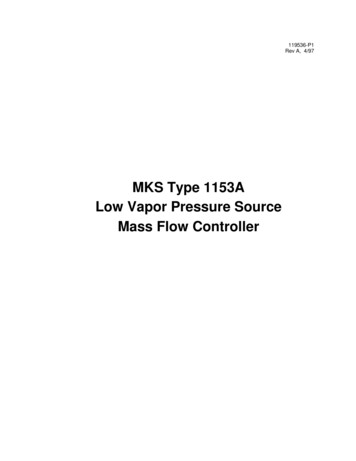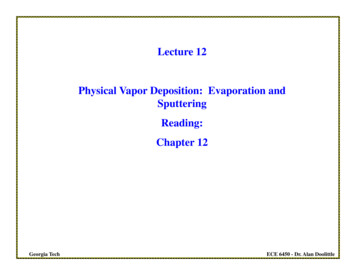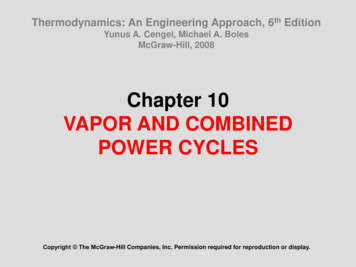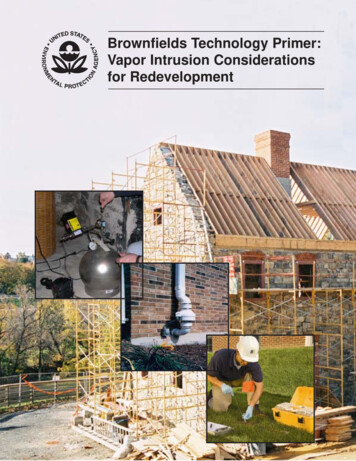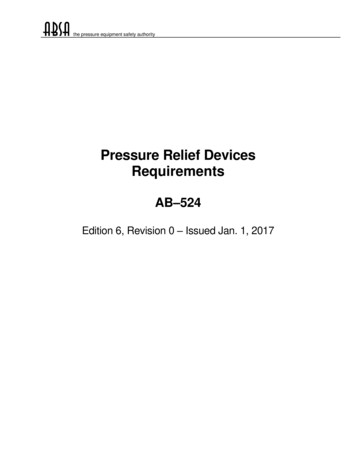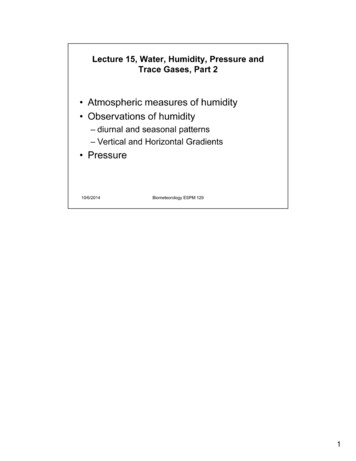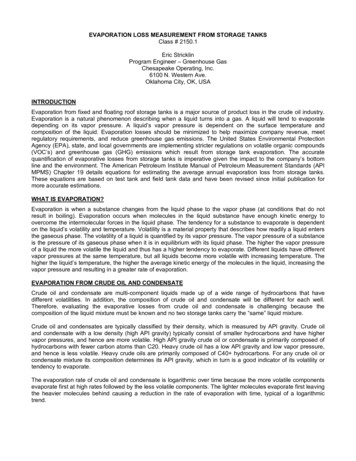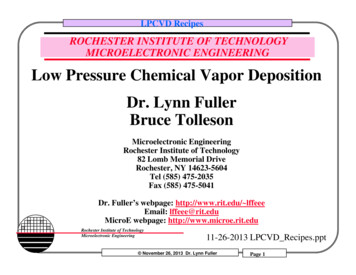
Transcription
LPCVD RecipesROCHESTER INSTITUTE OF TECHNOLOGYMICROELECTRONIC ENGINEERINGLow Pressure Chemical Vapor DepositionDr. Lynn FullerBruce TollesonMicroelectronic EngineeringRochester Institute of Technology82 Lomb Memorial DriveRochester, NY 14623-5604Tel (585) 475-2035Fax (585) 475-5041Dr. Fuller’s webpage: http://www.rit.edu/ lffeeeEmail: lffeee@rit.eduMicroE webpage: http://www.microe.rit.eduRochester Institute of TechnologyMicroelectronic Engineering11-26-2013 LPCVD Recipes.ppt November 26, 2013 Dr. Lynn FullerPage 1
LPCVD RecipesOUTLINEIntroductionLPCVD NitrideStociometricLow Stress – Silicon RichStress in Nitride FilmsLPCVD PolyPoly for CMOS (6000Å)Poly for MEMS (2µm High Dep Rate)Stress in Poly FilmsDoping PolyLPCVD Oxide (LTO)UniformityLPCVD ParyleneRochester Institute of TechnologyMicroelectronic Engineering November 26, 2013 Dr. Lynn FullerPage 2
LPCVD RecipesLOW PRESSURE CHEMICAL VAPOR DEPOSITION(LPCVD)Profile ThermocoupleHeat ooTo PumpandBurn BoxDoorLPCVD Low Pressure CVD SystemRochester Institute of TechnologyMicroelectronic Engineering November 26, 2013 Dr. Lynn FullerPage 3Gas in
LPCVD RecipesRIT LPCVD TOOLS4” LPCVD6” LPCVDTop Tube for LTORochester Institute of TechnologyMicroelectronicBottomEngineeringTube for Poly and Nitride November 26, 2013 Dr. Lynn FullerPage 4
LPCVD RecipesBURN BOXThe correct name is controlledcombustion/reaction system. Exhaust gasexits through the “burn box” which isheated to 850 C. At this temperature theexhaust gas reacts with air and anymaterial that can burn is burned undercontrolled conditions within the “burnbox”Rochester Institute of TechnologyMicroelectronic Engineering November 26, 2013 Dr. Lynn FullerPage 5
LPCVD Recipes6” LPCVD STOCIOMETRIC NITRIDESilicon Nitride (Si3N4) (normal - stociometric):Temperature 810 C Flat from (door to pump)Pressure 400 mTorr3SiH2Cl2 4NH3 Si3N4 9H2 3Cl2Dichlorosilane (SiH2Cl2) Flow 60 sccmAmmonia (NH3)Flow 150 sccmRate 60 Å/min /- 10 Å/minnon uniformity of 10%At 300 mTorr with same conditions as aboveRate 55 Å/min /- 10%non uniformity 3%Silicon Nitride (Si3N4) (low - stress)Temperature 800 C FlatPressure Dichlorosilane 200Ammonia 20Rate non uniformity Rochester Institute of TechnologyTough onpump and burn box, lots of HCL and Cl byproductsMicroelectronic Engineering November 26, 2013 Dr. Lynn FullerPage 6
LPCVD Recipes4” LPCVD STOCIOMETRIC NITRIDESilicon Nitride (Si3N4) (normal - stociometric):Temperature 790-800-810 C Ramp from (door to pump)Pressure 375 mTorr3SiH2Cl2 4NH3 Si3N4 9H2 3Cl2Dichlorosilane (SiH2Cl2) Flow 60 sccmAmmonia (NH3)Flow 150 sccmRate 60 Å/min /- 10 Å/minRochester Institute of TechnologyMicroelectronic Engineering November 26, 2013 Dr. Lynn FullerPage 7
LPCVD RecipesSTRESS IN SILICON NITRIDE FILMSCompressively stressed films would like to expand parallel to thesubstrate surface, and in the extreme, films in compressive stress willbuckle up on the substrate. Films in tensile stress, on the other hand,would like to contract parallel to the substrate, and may crack if theirelastic limits are exceeded. Stresses can be negative or positive or nearzero depending on many ster Institute of TechnologyMicroelectronic Engineering November 26, 2013 Dr. Lynn FullerPage 8
LPCVD RecipesSTRESS IN NITRIDE FILMSStress in an 8000 ANitride Film causingfractureRochester Institute of TechnologyMicroelectronic Engineering November 26, 2013 Dr. Lynn FullerPage 9
LPCVD RecipesLOW STRESS SILICON RICH Si3N4ADE Measured stress for various Ammonia:Dichlorosilane FlowRatiosFlow Stress x E 9 dynes/cm210:1 14.635:1 14.812.5:1 12.47 *Stress; σ (E/(6(1-v)))*(D2/(rt))1:1 10.13where E is Youngs modulus,1:2.5 7.79v is Poissons ratio,1:5 3D and t are substrate and film thickness1:10 0r is radius of curvature ( for tensile)* standard recipeT.H Wu, “Stress in PSG and Nitride Films as Related to FilmProperties and Annealing”, Solid State Technology, p 65-71,May ‘92Rochester Institute of TechnologyMicroelectronic Engineering10 dyne/cm2 1 newton/m2 1 Pascal November 26, 2013 Dr. Lynn FullerPage 10
LPCVD RecipesMEASUREMENT OF STRESS IN Si3N4Kenneth L. Way, Jr. did his senior project on stress in silicon nitridefilms as a function of the ratio of ammonia to dichlorosilane.Samples were coated with various flows and stress was measured atADE corporation. The silicon nitride was etched off of the backsideof the wafer so that the stress curvature was due to the layer on thefront side only. Dr. Lane said the nitride runs at 1:10(ammonia:dichlorosilane) ratios are rough on the pumping system.Compressive StressTensile StressDr. Grande sent samples to Kodak for stress measurement. Hefound stress of 900 MPa Tensile for the standard Nitride recipe for1500 A thickness, 1-29-2000Rochester Institute of TechnologyMicroelectronic Engineering10 dyne/cm2 1 newton/m2 1 Pascal November 26, 2013 Dr. Lynn FullerPage 11
LPCVD Recipes6” LPCVD LOW STRESS SILICON NITRIDESilicon Nitride (Si3N4) (low - stress)Temperature 800 C FlatPressure Dichlorosilane 200Ammonia 20Rate non uniformity Tough on pump and burn box, lots of HCL and Cl byproducts, we do notrun this process very often.Rochester Institute of TechnologyMicroelectronic Engineering November 26, 2013 Dr. Lynn FullerPage 12
LPCVD Recipes4” LPCVD LOW STRESS SILICON NITRIDESilicon Nitride (Si3N4) (low stress – silicon rich):Temperature 790-800-810 C Ramp from (door to pump)Pressure 650 mTorr3SiH2Cl2 4NH3 Si3N4 9H2 3Cl2Dichlorosilane (SiH2Cl2) Flow 200 sccmAmmonia (NH3)Flow 20 sccmRate 80 Å/min /- 10 Å/minFilms can be deposited up to about 5000 Å directly on silicon before the stressis so large that the film fractures (Dr. Lane, Dr. Fuller). Pad oxide under thenitride film and special silicon rich nitride films may allow nitride filmthickness over 5000 Å.9-6-96 Dr. Fuller did a 100 min deposition giving 8100Å (center) to 8800Å(edge) nitride thickness which did not fracture due to stress. It is a definiteimprovement.Rochester Institute of TechnologyMicroelectronic Engineering November 26, 2013 Dr. Lynn FullerPage 13
LPCVD Recipes6” LPCVD POLYSILICON FOR CMOSPolysilicon Deposition:Temperature 610 CPressure 300 mTorrGas Silane (SiH4)Flow 90 sccmRate 64 Å/minSiH4 Si 2H2Rochester Institute of TechnologyMicroelectronic Engineering November 26, 2013 Dr. Lynn FullerPage 14
LPCVD Recipes6” LPCVD POLYSILICON FOR MEMSHigh Dep. Rate Polysilicon Deposition:Temperature 650 CSiH4 Si 2H2Pressure 300 mTorrGas Silane (SiH4)Flow 400 sccmRate 200 Å/min ( 3 times the normal dep. rate at 610 C)Thicker films have larger grain size (grain size equal to film thickness) andthus a rougher appearance.Rochester Institute of TechnologyMicroelectronic Engineering November 26, 2013 Dr. Lynn FullerPage 15
LPCVD Recipes4” LPCVD POLYSILICON FOR CMOSPolysilicon Deposition:Temperature 610 CPressure 300 mTorrGas Silane (SiH4)Flow 90 sccmRate 77 Å/minSiH4 Si 2H2device wafersevery other slotFrontsRochester Institute of TechnologyMicroelectronic Engineering5 fillers everyother slot November 26, 2013 Dr. Lynn Fuller1 fillerat endPage 16
LPCVD Recipes4” LPCVD POLYSILICON FOR MEMSHigh Dep. Rate Polysilicon Deposition:Temperature 650 CSiH4 Si 2H2Pressure 300 mTorrGas Silane (SiH4)Flow 90 sccmRate 235 Å/min ( 3 times the normal dep. rate at 610 C)Thicker films have larger grain size (grain size equal to film thickness) andthus a rougher appearance.Rochester Institute of TechnologyMicroelectronic Engineering November 26, 2013 Dr. Lynn FullerPage 17
LPCVD RecipesDOPING POLYSILICON FROM SPIN-ON DOPANTSWhen using poly as a conductor in integrated circuits it is desirable to have low resistivity.Doping at 1000 C for 20 min using Emulsitone Co., 19 Leslie Court, Whippany, NJ 07981Tel (201)386-0053; Emitter Diffusion Source N250 spin-on dopant gives 10-15 ohm/sq sheetresistance for 0.75 um thick poly. (The Allied Signal Inc., 1090 South Milpitas Boulevard,Milpitas, CA 95035, Tel (408)946-2411, Accuspin P-854 dopant gives higher resistivity inthe range of 100 ohm/sq.)There is no problem unless one is concerned with the possibility of the dopant going througha thin gate oxide and affecting the underlying substrate. In this case the doping needs to beadequate however the subsequent high temperature steps each drive the dopant furtherthrough the gate oxide. CV measurements can be used to see if the dopant gets through tothe substrate. For n-type dopant and p-type substrate one would expect a shift to the left ifthe dopant goes through the gate. We found that doping at 1000 C for 10 min soak, usingN250 spin on source, followed by 60 min in nitrogen at 1000 C did not cause a shift to theleft in the CV plot. (actually shifted right . similar to anneal or sinter) We did not test thebreakdown voltage or effect of gate oxide doping on breakdown voltage. We did not tryadditional time atRochester1000 InstituteC in ofNitrogenTechnology looking for shift to left in CV plot.Microelectronic Engineering November 26, 2013 Dr. Lynn FullerPage 18
LPCVD RecipesDOPING POLYSILICON BY ION IMPLANTIn the advanced CMOS process we want N poly on the NMOSFETand P poly on the PMOSFET. So the poly is deposited undoped andduring D/S implant the poly is also doped.In the submicron CMOS process we dope the poly after deposition n for both transistors. We use a dose of 2E16 which is the highest dosethat we typically do at RIT. Since there is no resist on the wafer we donot have to consider heating effects during implant. The current is setas high as possible, often 500uA or more.Rochester Institute of TechnologyMicroelectronic Engineering November 26, 2013 Dr. Lynn FullerPage 19
LPCVD RecipesDOPING POLYSILICON BY ION IMPLANTIn some analog CMOS processes we want high sheet resistance polyresistors for voltage dividers, etc. The measured resistor data belowshows sheet resistance versus Boron (B11) dose for a 3500Å poly layerafter 30 min.1000 C anneal.R 1/slope; Rhos R / #sqs; Rho Rhos x thickness (3500Å); Dose implanter settingR wafer 4 106 G ; Rhos 2.94 Gohm/sq; Rho 103K ohm-cm; Dose 1E12 cm-2R wafer 3 339 G ; Rhos 9.42 Gohm/sq; Rho 330K ohm-cm; Dose 3E11R wafer 2 943 G ; Rhos 26.2 Gohm/sq; Rho 917K ohm-cm; Dose 6E11R wafer 1 1104 G; Rhos 30.7 Gohm/sq; Rho 1075K ohm-cm; Dose 1E11Rochester Institute of TechnologyMicroelectronic Engineering November 26, 2013 Dr. Lynn FullerPage 20
LPCVD RecipesSTRESS IN POLY FILMSStress in poly films can causebuckling and bending of beamsand cantilever structures. Whendoping poly after deposition thehigh temperatures (1000 C) willanneal stress. Undoped polystructures require an anneal.Rochester Institute of TechnologyMicroelectronic Engineering November 26, 2013 Dr. Lynn FullerPage 21
LPCVD RecipesLOW TEMPERATURE OXIDE (LTO)Wafers are loaded backto back in caged boat.The boat is filled withdummy wafer to total25 wafers. Monitorwafer is placed in themiddle. Injector tubesdirect the gas (SiH4 andO2) directly under themiddle of the cagedboat.Caged BoatRochester Institute of TechnologyMicroelectronic Engineering November 26, 2013 Dr. Lynn FullerPage 22
LPCVD RecipesIMPROVED UNIFORMITY OF LTO WITH CAGED BOATIn 4” LPCVDRochester Institute of TechnologyMicroelectronic EngineeringUsing 6” LPCVDCaged Boat and Injectors November 26, 2013 Dr. Lynn FullerPage 23
LPCVD Recipes6” LTO RECIPELow Temperature Silicon Oxide:Temperature 400 CSiH4 O2 SiO2 2H2Pressure 250 mTorrSilane (SiH4)Flow 40 sccmOxygen (O2)Flow 48 sccmRate 70 Å/min /- 10 Å/min7-26-00 LTO @425 C gave deposition rate of 113 Å/minRochester Institute of TechnologyMicroelectronic Engineering November 26, 2013 Dr. Lynn FullerPage 24
LPCVD RecipesOXIDE THICKNESS COLOR 4700ColorTanBrownDark Violet - Red VioletRoyal BlueBlueLight Blue - Metallic BlueMetallic - very light Yellow GreenLIght Gold or Yellow - Slightly MetallicGold with slight Yellow OrangeOrange - MelonRed VioletBlue - Violet BlueBlueBlueBlue - Blue GreenLight GreenGreen - Yellow GreenYellow GreenYellowLight OrangeCarnation PinkViolet RedRed VioletVioletBlue 90010000ColorBlueBlueBlue GreenGreenYellow GreenGreenYellowYellow -"Yellowish"(at times appears to be Lt gray or matellic)Light Orange or Yellow - PinkCarnation PinkViolet Red"Bluish"(appearsviolet red, Blue Green, looks grayish)BlueBlueBlue Green - Green"Yellowish"OrangeSalmonDull, LIght Red VioletVioletBlue VioletBlueBlueBlueBlue GreenDull Yellow GreenYellow - "Yellowish"OrangeCarnation PinkNitride Thickness (Oxide Thickness)(Oxide Index/Nitride Index)Rochester Institute of TechnologyEg. Yellow Nitride Thickness (2000)(1.46/2.00) 1460Microelectronic Engineering November 26, 2013 Dr. Lynn FullerBluePage 25PLAY
LPCVD RecipesNITRIDE MEASUREMENTSEllipsometer Program 7 does nitride on pad oxideNanospec Program 6 does nitride on pad oxideSpectromap does nitride on pad oxideYou need to know the value of the pad oxide thickness.Rochester Institute of TechnologyMicroelectronic Engineering November 26, 2013 Dr. Lynn FullerPage 26
LPCVD RecipesPARYLENE DEPOSITION SYSTEMApproximately 1 gm ofParylene C gives 3000Å filmthickness, Deposit 5 wafers perrun.Descovered we need A174Adhesion Promotor. Chemicalname gammamethacryloxypropyltrimethoxysilane. Spin coat straight frompackage at 2000 rpm. Bake onhot plate at 115 C for 1 min.See: ochester Institute of TechnologyMicroelectronic Engineering November 26, 2013 Dr. Lynn FullerPage 27
LPCVD RecipesPARYENE MINI OPERATION MANUALMini Operation Manual for the PDS-2010 – Parylene Deposition SystemRevision 4-30-04Dr. Lynn Fuller, Germain FengerClean up Prior to Deposition:1. Open the storage drawer under the white table. Contains Parylene powder,cleaning tools, microclean-90 spray cleaner, concentrate of microclean-90 andspare parts. (If necessary mix more microclean-90 by diluting with water a fewcaps full per spray bottle)2. Clean around seal, on Bell Jar and Stage. Only clean the inside of Bell Jar andcenter on stage if there is visible pealing.3. Spray microclean-90 on parts that have been cleaned and are exposed.4. Verify that the small pressure sensor hole is clear of deposition, if it is not use asmall hook tool to remove the deposition. Do not push the parylene residue furtherin the hole.5. Clean the chiller (back right corner). Remove the chiller being careful of the tubeson the end of the chiller (inside of black cover) for they bend easily. Use a scourpad to remove the majority of the deposition, some deposition may require the useof a razor blade. Spray with micro-90 when done.6. Remove Deposition Tube and verify that it is not clogged, or the hole that it goesinto.Set up for Deposition:1. Open the front cabinet door. Unclamp and open the vaporizer door on the lowerleft. Remove the aluminum foil Dimer boat. If you need to make a new Dimerboat see page 18 of the manual.2. One gram of Parylene type C from Specialty Coating Systems, 5707 WestMinnesota St., Indianapolis, IN 46241, gives1 micrometer of thickness. Measureout the desired amount of Parylene powder. Use the gram scale near the 4 ptprobe. Lift off the glass cover, turn ON, set zero 0 , set foil on top of scale, settear T (reading should go to zero), using the scoop put some powder on the foilto desired amount. Pour the measured amount of powder into the aluminum foilDimer boat.3. Place boat with powder in the vaporizer and close and clamp the door.4. Place wafers in the designated boats (in storage cabinet).Rochester Institute of TechnologyMicroelectronic EngineeringStart System:1. Card Swipe in.2. Place wafers on stage, pull EMO, turn the switch labeled vaporizer on and verifythat the boat does not rub on anything, if it is found to be rubbing adjust boatposition, turn off vaporizer.3. Place bell jar on stage.4. Turn on vaporizer, and again verify that the boat is not rubbing, if it is rubbingremove bell jar and adjust.5. While holding the chiller in place, turn right switch to vacuum, once under vacuumyou may release the chiller.6. Turn on the chiller, (left green switch)7. Turn on furnace switch and vaporizer.8. Once pressure reads below 30mTorr (base pressure) push the green button (right). November 26, 2013 Dr. Lynn FullerPage 28
LPCVD RecipesREFERENCES1. Silicon Processing for the VLSI Era, Volume 1, 2nd Edition,Stanley Wolf, Richard Tauber, Lattice Press, 2000.2. The Science and Engineering of Microelectronic Fabrication,Stephen A. Campbell, Oxford University Press, 1996.Rochester Institute of TechnologyMicroelectronic Engineering November 26, 2013 Dr. Lynn FullerPage 29
9-6-96 Dr. Fuller did a 100 min deposition giving 8100Å (center) to 8800Å (edge) nitride thickness which did not fracture due to stress. It is a definite improvement. LPCVD Recipes . DOPING POLYSILICON BY ION IMPLANT In the advanced CMOS process we want N poly on the NMOSFET and P poly on the PMOSFET. So the poly is deposited undoped and
